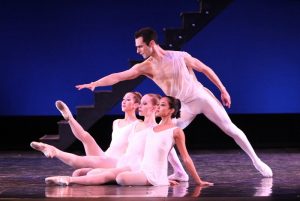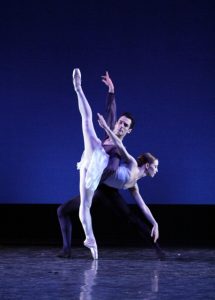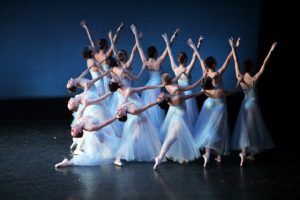City Ballet of SD’s ‘Balanchine Masterworks’ is Thrilling, Timeless Treat

“Apollo”
Choreography by George Balanchine
©The George Balanchine Trust
Photo by Chelsea Penyak
the muses from left to right: Kyndra Ricker, Ariana Samuelsson, Erica Alvarado
Four dances that balanced weight and weightlessness and focused on the beauty and grace of the human body in City Ballet of San Diego’s Balanchine Masterworks at the Spreckels Theatre were a thrilling treat for the senses.
Tense combinations of classicism, modernism, and Romanticism – and pure form – were performed at the highest level and artistry. With the addition of a crisp live orchestra, the company has never performed Balanchine with such sweeping musicality.
Balanchine had a revelation in the late 1920s when he heard Igor Stravinsky’s spare music. He was inspired to eliminate the hard edge of Soviet Modernism and created Apollo (originally Apollon musagète). A ballet in two tableaux, Apollo the Greek god of music, frolics with his three muses: Terpsichore, muse of dance and song; Polyhymnia, muse of mime; and Calliope, muse of poetry.
While the subject of the ballet is ancient, the dance is contemporary. As Apollo, Geoffrey Gonzalez climbed up and down a wooden framework that evoked a vintage lifeguard tower. His sheer white costuming suggested he was a god who didn’t fear the sun or need sunscreen.
At his birth atop the frame 15 feet above the stage, he appeared unformed and restricted to small childlike steps. The muses then civilized him and made him a god. Led by Ariana Samuelsson as Terpsichore, Erica Alvarado as Polyhymnia, and Kyndra Ricker, as Calliope, he gradually moved more elegantly.
Movement was distinctly modern: knees bent into low spiraling pivots, feet flexed, bodies contracted and off center. Gonzalez elicited gasps during jumps that changed direction at the hip in midair.
The muses traveled effortlessly over the stage. Their arms entwined, and they posed with flat palms upward. Apollo stroked their faces one by one, yet when on their backs, their legs rose up robotically stiff. There were flashes of metaphors tied to paintings and statues, as when Apollo reached back for Terpsichore, and fingers touched. That deftly suggested Michelangelo’s image in the Sistine Chapel.
In his final climb up the wooden riser, one was awestruck by the deep blue background, created here by Stephen Judson. How did Balanchine (and his new producer Diaghilev) light the stage at the Paris Opera in 1928? Or even in 1947? After the war, the theatre was in rough shape. Maria Tallchief, Balanchine’s new wife, (the third of four) danced the role of Terpsichore. The stage was “treacherously raked” and her ankle was still healing from a recent injury. But the French loved her, and Balanchine was on his way.
All of Balanchine’s wives were ballerinas. And he made many dances about his love for women, women who are independent, and women not afraid to let their hair down. He went on to found New York City Ballet with Lincoln Kirstein. Of all his ballets, The Nutcracker is best known and draws from childhood memories and Petipa’s revival.
Balanchine died in 1983, and his legacy is handled by the Balanchine Trust. Only the very best dance companies are given license to perform his demanding choreography. Licensed ballets require an approved “repetiteur” to stage the work in rehearsals and get the work on stage for the premiere. City Ballet (of San Diego) has 17 Balanchine ballets in its repertoire, and premiered Allegro Brillante as part of this Balanchine Masterworks program.
City’s founding artistic director Steven Wistrich considers Balanchine a mentor. He was dancing with a Swiss ballet company in the mid-70s when Balanchine traveled to Geneva to coach him and fellow dancers on the complexities of Allegro Brillante (1956), which Balanchine created with Tallchief in mind and called, “everything I know about classical ballet in 13 minutes.”
That brief collaboration for Wistrich 40 years ago may explain why Allegro Brillante was such a strong work for the men on the Spreckels stage.
Set to music by Tchaikovsky, Erica Alvarado and Stephano Candreva were lovely as the leads, youthful and well-rehearsed. Alvarado took a spill during the knotted choreography and recovered in a wink. Four more couples joined them in fine form.
Yet the finest turns, timing, and counterpoint came from the men when they left their partners. Trystan Loucado, a tall favorite guest artist, Carlo Di Dio, a strong guest from the sketchy California Ballet, and company members Derek Lauer and Ryosuke Ogura offered excellent uniformity, an impressive feat for a group of varied height and body types.
[php snippet=1]
Sonatine premiered in New York in 1975, to mark the 100th anniversary of composer Maurice Ravel’s birth. It was last performed by City Ballet of San Diego in 2010. The work was far more engaging this time around.

“Sonatine”
Choreography by George Balanchine
©The George Balanchine Trust
Photo by Chelsea Penyak
dancers: Geoff Gonzalez, Ariana Samuelsson
One can’t overstate the power of having pianist Nina Flowers play Ravel’s score on stage just inches away from the two dancers, Gonzalez and Samuelsson.
Musical notes entered their bodies and their dance conversation filled with pleasing turns and chemistry began. Handsome costumes by Jannifer Mah dressed Gonzalez in dark tights and a deep plum tunic, Samuelsson in icy blue. Balanchine’s choreography had them dance every note of the score that starts as a light waltz but builds to a tour de force in arpeggios and polyrhythms.

“Serenade”
Choreography by George Balanchine
©The George Balanchine Trust
Photo by Chelsea Penyak
Serenade was Balanchine’s first American ballet and featured students from his new school. It was originally presented in 1934 outdoors at a grand estate. Karinska is listed as costumer, but did not design the long blue tulle skirts we see today. The original costumes were short tunics.
It has no plot. Instead, Balanchine gathered incidents from rehearsals such as the dancer who fell. (Inquiring minds want to know about the bun magic. How did Arianna Samuelsson fall to the floor and magically loose her bun in one swoop? Ah, the magic of the theater, to go from bun to loose hair with only one pin.) And the dancer who arrived late, and those who shaded their eyes from the sun.
The music started, the stage was a sea of blue, raised hands dropped at the wrist and touched foreheads, dancers’ feet opened to the first position. It all felt spontaneous yet urgent, simple, yet profound. Samuelsson, Alvarado, and Megan Jacobs were the leads, but everyone emerged from the corps de ballet. One of the strongest there was Kate Arnson.
There were images from life and art. Ms. Samuelsson was lifted by the three men, trailed by a living cross in the form of Ms. Jacobs.
While some in the corps have room to grow, the season ahead looks very bright. City Ballet was so top shelf in this production, far beyond the artistry of other local ballet companies, that it deserves more attention and support. And longer runs. Every seat in the glorious Spreckels Theatre should be filled.
City Ballet of San Diego continues with Swan Lake Act II and Mozart’s Requiem May 9-11, 2014. http://www.cityballet.org/index.php

Kris Eitland covers dance and theater for Sandiegostory.com and freelances for other publications, including the Union Tribune and Dance Teacher Magazine. She grew up performing many dance styles and continued intensive modern dance and choreography at the Univ. of Minnesota, Duluth, and San Diego State Univ. She also holds a journalism degree from SDSU. Her career includes stints in commercial and public radio news production.
Eitland has won numerous Excellence in Journalism awards for criticism and reporting from the San Diego Press Club. She has served on the Press Club board since 2011 and is a past president. She is a co-founder of Sandiegostory.com. She has a passion for the arts, throwing parties with dancing and singing, and cruising the Pacific in her family’s vintage trawler. She trains dogs, skis, and loves seasonal trips to her home state of Minnesota.

Saw it, loved it.